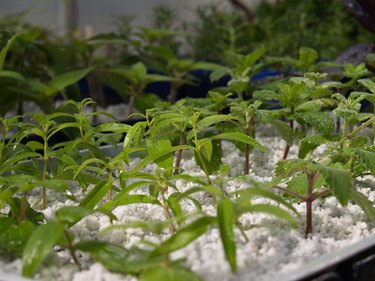Things You'll Need
Flowering fruit plants
Fruit growers reference book (optional)
Cotton swabs
Seedling trays
Starter soil mix (fruit and vegetable)
Seedling pots
Plastic wrap
Water
Grow light

The popularity of crossbreeding two fruit plants is increasing dramatically. This is best illustrated by noting the unique names of fruits now being sold in grocery stores. Gardening enthusiasts can easily enjoy some of the unique tastes derived from experimenting with new fruit combinations by following a few simple horticulture rules of thumb. Many unique combinations of crossbred fruit are possible, and many result in a fruit that has all the properties desired (such as new taste) with none of the undesired attributes (such as poor texture). Imagination and a few simple rules are all that is needed to excel in crossbreeding two fruit plants.
Step 1
Select several combinations of fruit plants that you want to crossbreed. Closely related fruits such as berries with berries or citrus with citrus are most easily crossbred for beginners. The goal is to select enough combinations so that several different combinations have a chance to crossbreed successfully.
Video of the Day
Step 2
Determine specific planting variables for your selected fruits such as: best time for year to plant, weather considerations, heat and moisture constraints, soil preferences, light requirements, etc. A fruit-grower's guidebook can help you determine these variables.
Step 3
Collect a plentiful amount of pollen from each fruit sample with a cotton swab. Swab the outside of the anthers (the male part that contains the pollen sacs) on each flower. Carefully mark each swab for identification and lay the swabs aside.
Step 4
Rub the cotton swab containing pollen sample onto the stigma area (the female part that contains the ovary) of the base fruit, which is the fruit to be altered. Properly care for the plant thereafter to maximize its growth until harvest time.
Step 5
Pick the fully ripened fruit. Make sure you do not pick fruit that is immature, because this will decrease the chances of successful crossbreeding results. Harvest the seeds from the ripe fruit.
Step 6
Fill a seedling tray with starter soil mix, and lightly dampen with water. Plant the seeds in accordance with standard seed practice for that particular fruit (depth, moisture, light etc.) Cover the seedling tray with clear plastic wrap and place under a grow light. Water and care as indicated for that particular fruit seedling.
Step 7
Remove the plastic wrap after you see sprouts forming. When two leaves appear, transplant the seedlings into standard seedling pots. Move the plants to their permanent location when they become large enough to flourish on their own. These are crossbred plants and should produce an interesting fruit.
Tip
Growing fruit is as much an art as a science, so be patient. It may take several attempts to perform a successful crossbreeding.
Video of the Day